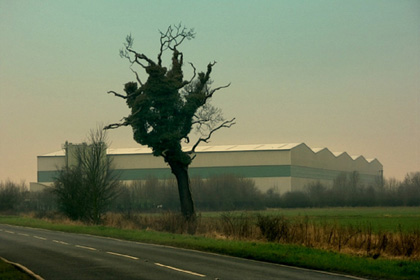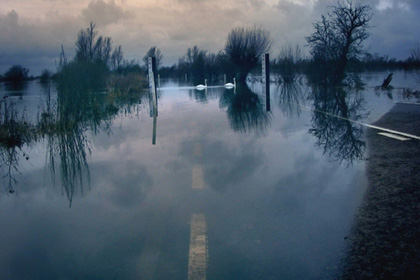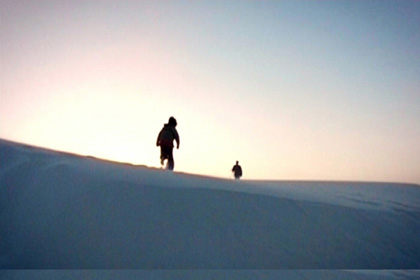Close up
Grey area: Chris Petit’s Content

Mark Fisher is mesmerised by Chris Petit’s essay documentary, an ‘informal coda’ to his 1979 film Radio On
At one point in Chris Petit’s haunting new film Content, we drive through Felixstowe container port. It was an uncanny moment for me, since Felixstowe is only a couple of miles from where I live – what Petit filmed could have been shot from our car window. What made it all the more uncanny was the fact that Petit never mentions that he is in Felixstowe; the hangars and looming cranes are so generic that I began to wonder if this might not be a doppelgänger container port somewhere else in the world. All of this somehow underlined the way Petit’s text describes these “blind buildings” while his camera tracks along them: “non-places”, “prosaic sheds”, “the first buildings of a new age” which render “architecture redundant”.
Content could be classified as an essay film, but it’s less essayistic than aphoristic. This isn’t to say that it’s disconnected or incoherent: Petit himself has called Content a “21st-century road movie, ambient”, and its reflections on ageing and parenthood, terrorism and new media are woven into a consistency that’s non-linear, but certainly not fragmentary.
Content is about ‘correspondence’, in different senses of the word. It was in part generated by electronic correspondence between Petit and his two major collaborators: writer Ian Penman (whose text is voiced by the German actor Hanns Zischler) and the German musician Antye Greie. Penman’s text is a series of reflections on the subject of email, that “anonymous yet intimate” ethereal communication. Some of Penman’s disquisitions on email are accompanied by images of postcards – the poignant tactility of this obsolete form of correspondence all the more affecting because the senders and addressees are now forgotten. Greie, meanwhile, produces skeins of electronica that provide Content with a kind of sonic unconscious in which terms and concepts referred to in the images and the voice track are refracted, extrapolated and supplemented.

One of the first phrases cited in Greie’s soundwork – which resembles sketches for unrealised songs – is a quotation from Roy Batty’s famous speech in Blade Runner: “If only you could see what I have seen with your eyes.” This is a phrase Penman has made much of in his own writings on recording, technology and haunting – and it brings us to the other meaning of ‘correspondence’ Content plays with: correspondences in the sense of connections and associations. Some of these are underscored by Petit in his dryly poetic text; others he leaves the viewers to make for themselves.
One of the most gratifying aspects of Content, in fact, is that by contrast with so many contemporary television documentaries, which neurotically hector the audience by incessantly reiterating their core thesis, Petit trusts in the intelligence and speculative power of the viewer. Where so much television now involves a mutual redundancy of image and voice – the image is slaved into illustrating the text; the voice merely glosses the image – Content is in large part about the spaces between image and text, what is unsaid in (and about) the images.
The use of a German actor and musician and the many references to Europe in Content reflect Petit’s childhood which, as he describes in the film, was partly spent as a forces child in Germany. But it also reflects Petit’s long-standing desire for some kind of reconciliation between British culture and European modernism. Petit has described Content as an “informal coda” to his 1979 film Radio On (recently reissued on BFI DVD). With its strong debt to European art cinema, Radio On projected a rapprochement between British and European film that never happened – a rapprochement anticipated in the 1970s art pop (Kraftwerk, Bowie) used so prominently in that film. Petit imagined a British cinema that, like that music, could assert its Europeanness not by rejecting America, but by confidently absorbing American influences. Yet this future never arrived.

“Radio On,” Petit said in a recent interview, “ended with a car ‘stalled on the edge of the future’, which we didn’t know then would be Thatcherism.” Ahead lay a bizarre yet banal mix of the unprecedented and the archaic. Instead of accelerating down Kraftwerk’s autobahn, we found ourselves, as Petit puts it in Content, “reversing into a tomorrow based on a non-existent past”, as the popular modernism Radio On was part of found itself eclipsed by a toxic-addictive confection of consumer-driven populism, heritage kitsch, xenophobia and US corporate culture. In this light, Content stands as a quiet but emphatic reproach to the British cinema of the last 30 years, which in its dominant variants – drab social realism, faux gangster, picture-book costume drama or mid-Atlantic middle-class fantasia – has retreated from modernity. It isn’t only the poor and the non-white who are edited out of Notting Hill, for example – it’s also the Westway, west London’s Ballardian flyover, which now stands as a relic of “the modern city that London never became”.
Yet Content isn’t just a requiem for the lost possibilities of the last 30 years. In its use of stunning but underused locations – the ready-made post-Fordist science-fiction landscapes of Felixstowe container port, the eerie Cold War terrain of nearby Orford Ness – Content demonstrates not only what British cinema overlooks, but what it could still be.
‘Content’ shows on More4 on 9 March. Independent cinema screening dates and venue details to be confirmed
See also
Family photos: Sukhdev Sandhu revels in John Akomfrah’s Mnemosyne cine-essays on migration and memory (February 2010)
